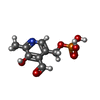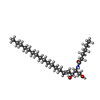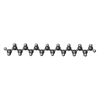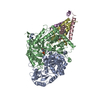+Search query
-Structure paper
| Title | Ceramide sensing by human SPT-ORMDL complex for establishing sphingolipid homeostasis. |
|---|---|
| Journal, issue, pages | Nat Commun, Vol. 14, Issue 1, Page 3475, Year 2023 |
| Publish date | Jun 13, 2023 |
 Authors Authors | Tian Xie / Peng Liu / Xinyue Wu / Feitong Dong / Zike Zhang / Jian Yue / Usha Mahawar / Faheem Farooq / Hisham Vohra / Qi Fang / Wenchen Liu / Binks W Wattenberg / Xin Gong /   |
| PubMed Abstract | The ORM/ORMDL family proteins function as regulatory subunits of the serine palmitoyltransferase (SPT) complex, which is the initiating and rate-limiting enzyme in sphingolipid biosynthesis. This ...The ORM/ORMDL family proteins function as regulatory subunits of the serine palmitoyltransferase (SPT) complex, which is the initiating and rate-limiting enzyme in sphingolipid biosynthesis. This complex is tightly regulated by cellular sphingolipid levels, but the sphingolipid sensing mechanism is unknown. Here we show that purified human SPT-ORMDL complexes are inhibited by the central sphingolipid metabolite ceramide. We have solved the cryo-EM structure of the SPT-ORMDL3 complex in a ceramide-bound state. Structure-guided mutational analyses reveal the essential function of this ceramide binding site for the suppression of SPT activity. Structural studies indicate that ceramide can induce and lock the N-terminus of ORMDL3 into an inhibitory conformation. Furthermore, we demonstrate that childhood amyotrophic lateral sclerosis (ALS) variants in the SPTLC1 subunit cause impaired ceramide sensing in the SPT-ORMDL3 mutants. Our work elucidates the molecular basis of ceramide sensing by the SPT-ORMDL complex for establishing sphingolipid homeostasis and indicates an important role of impaired ceramide sensing in disease development. |
 External links External links |  Nat Commun / Nat Commun /  PubMed:37308477 / PubMed:37308477 /  PubMed Central PubMed Central |
| Methods | EM (single particle) |
| Resolution | 2.7 - 3.1 Å |
| Structure data | EMDB-33864: Cryo-EM structure of C6-ceramide-bound SPT-ORMDL3 complex EMDB-33866, PDB-7yiy: EMDB-33868, PDB-7yj1: EMDB-33869, PDB-7yj2: |
| Chemicals |  ChemComp-PLP:  ChemComp-6CM:  ChemComp-R16:  ChemComp-Z1T: |
| Source |
|
 Keywords Keywords | TRANSFERASE/inhibitor / ceramide / TRANSFERASE-inhibitor complex / TRANSFERASE/INHIBITOR COMPLEX / TRANSFERASE-INHIBITOR COMPLEX complex |
 Movie
Movie Controller
Controller Structure viewers
Structure viewers About Yorodumi Papers
About Yorodumi Papers











 homo sapiens (human)
homo sapiens (human)